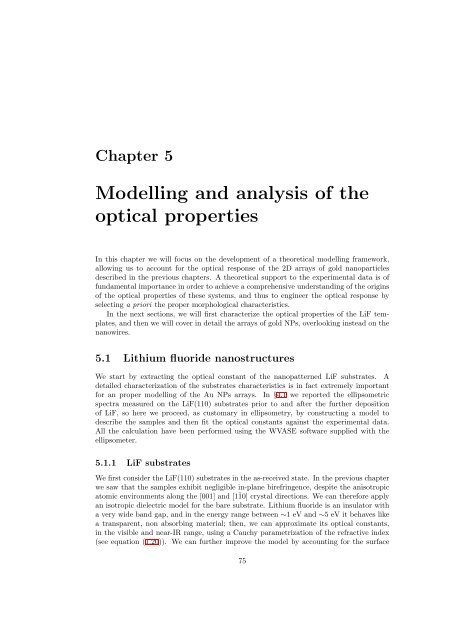Morphology and plasmonic properties of self-organized arrays of ...
Morphology and plasmonic properties of self-organized arrays of ...
Morphology and plasmonic properties of self-organized arrays of ...
You also want an ePaper? Increase the reach of your titles
YUMPU automatically turns print PDFs into web optimized ePapers that Google loves.
Chapter 5Modelling <strong>and</strong> analysis <strong>of</strong> theoptical <strong>properties</strong>In this chapter we will focus on the development <strong>of</strong> a theoretical modelling framework,allowing us to account for the optical response <strong>of</strong> the 2D <strong>arrays</strong> <strong>of</strong> gold nanoparticlesdescribed in the previous chapters. A theoretical support to the experimental data is <strong>of</strong>fundamental importance in order to achieve a comprehensive underst<strong>and</strong>ing <strong>of</strong> the origins<strong>of</strong> the optical <strong>properties</strong> <strong>of</strong> these systems, <strong>and</strong> thus to engineer the optical response byselecting a priori the proper morphological characteristics.In the next sections, we will first characterize the optical <strong>properties</strong> <strong>of</strong> the LiF templates,<strong>and</strong> then we will cover in detail the <strong>arrays</strong> <strong>of</strong> gold NPs, overlooking instead on thenanowires.5.1 Lithium fluoride nanostructuresWe start by extracting the optical constant <strong>of</strong> the nanopatterned LiF substrates. Adetailed characterization <strong>of</strong> the substrates characteristics is in fact extremely importantfor an proper modelling <strong>of</strong> the Au NPs <strong>arrays</strong>. In §4.1 we reported the ellipsometricspectra measured on the LiF(110) substrates prior to <strong>and</strong> after the further deposition<strong>of</strong> LiF, so here we proceed, as customary in ellipsometry, by constructing a model todescribe the samples <strong>and</strong> then fit the optical constants against the experimental data.All the calculation have been performed using the WVASE s<strong>of</strong>tware supplied with theellipsometer.5.1.1 LiF substratesWe first consider the LiF(110) substrates in the as-received state. In the previous chapterwe saw that the samples exhibit negligible in-plane birefringence, despite the anisotropicatomic environments along the [001] <strong>and</strong> [1¯10] crystal directions. We can therefore applyan isotropic dielectric model for the bare substrate. Lithium fluoride is an insulator witha very wide b<strong>and</strong> gap, <strong>and</strong> in the energy range between ∼1 eV <strong>and</strong> ∼5 eV it behaves likea transparent, non absorbing material; then, we can approximate its optical constants,in the visible <strong>and</strong> near-IR range, using a Cauchy parametrization <strong>of</strong> the refractive index(see equation (1.20)). We can further improve the model by accounting for the surface75
















